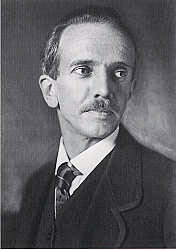Otto Bartning facts for kids
Otto Bartning (born April 12, 1883, in Karlsruhe; died February 20, 1959, in Darmstadt) was an important German architect. He was known for his Modernist style, which focused on simple, clean designs. Bartning was also a teacher and thought a lot about how buildings should be designed.
Early in his career, he worked with Walter Gropius to plan the famous Bauhaus school. He was also part of a group of architects called Der Ring. Later, in 1951, he became the president of the Federation of German Architects.
Contents
Otto Bartning's Early Life and Work
Otto Bartning was born in Karlsruhe. His father was a merchant. After finishing school in 1902, Bartning started studying at the Königliche Technische Hochschule in Berlin. This school is now known as the Technische Universität.
In 1904, he went on a long trip around the world for 18 months. After his travels, he came back to Berlin and Karlsruhe to finish his studies. While still a student, he began working as an architect in Berlin in 1905. He left his studies without officially graduating.
Designing Modern Churches
In 1910, Bartning built his first church in Germany. It was for a church group in Essen. Later, in 1929, he designed another church nearby called the Auferstehungskirche (Church of the Resurrection). This circular church became a very important example for how modern Protestant churches were built in Central Europe.
Working with Walter Gropius and the Bauhaus
After World War I, Otto Bartning became known for his ideas about changing art and design education. He worked closely with his friend, Walter Gropius. In 1918, they planned the idea for the Bauhaus school. Bartning helped create the program for the Bauhaus.
He influenced Gropius's famous 1919 Bauhaus manifesto. This manifesto talked about workshop principles and being open to new ideas from around the world. Bartning's own ideas for the Bauhochschule in 1926 were also based on these same principles.
The "Other Bauhaus" School
After the original Bauhaus school closed, the government in Thuringia asked Otto Bartning to lead a new school. This school was called the Staatliche Bauhochschule (Building High School). It was located in Weimar, in a building designed by Henry van de Velde.
This new school was often called "The Other Bauhaus." It tried to mix traditional teaching with the ideas from the original Bauhaus. The goal was to combine craft skills with design. The original Bauhaus was more about modern art, but Bartning's new school focused more on practical skills and crafts.
Students at "The Other Bauhaus" were encouraged to work on real projects. They also learned how to sell their designs. For example, in 1927, the weaving department made materials for the German Pavilion at the Milan Fair. Otto Bartning's own architecture office designed this pavilion.
From 1929 to 1931, Bartning was one of six leading Modernist architects. They were all members of Der Ring. They worked together on the Siemensstadt housing project, which created new homes for many people. In 1932, Bartning also shared his ideas for the inside design of a prefabricated house.
Otto Bartning's Later Career
In the 1930s, art and design became very political in Germany. Bartning tried to find a balanced way of working, but it became difficult. He wrote articles in a magazine called Die Volkswohnungen (People's Housing). These articles talked about ideas like land reform and Germany becoming self-sufficient through crafts.
In 1930, a new government came to power in Thuringia. Soon after, Bartning resigned from his role at the Bauhochschule. Many of the professors and teachers from "The Other Bauhaus" continued their careers in Germany. However, Bartning chose to focus on designing churches between 1933 and 1948.
Later in his life, he received special honors for his work. He was given honorary doctorates and became an honorary member of the RIBA (Royal Institute of British Architects). He also held important positions as an architect and advisor.
See also
 In Spanish: Otto Bartning para niños
In Spanish: Otto Bartning para niños


